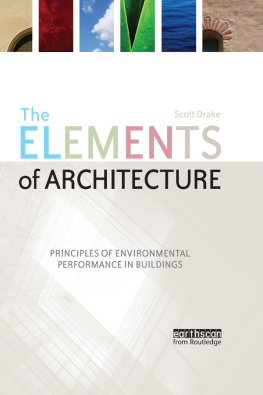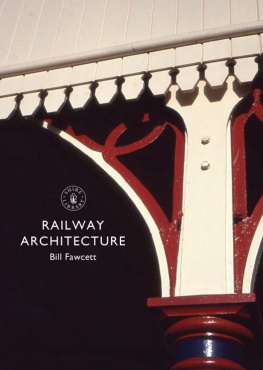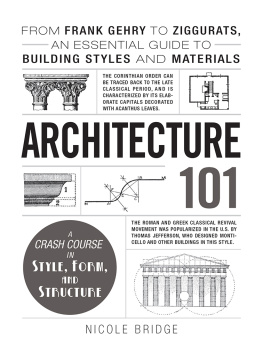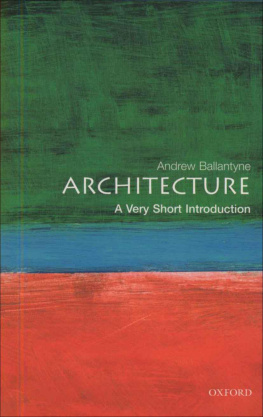Dr. Scott Drake - The elements of architecture : principles of environmental performance in buildings
Here you can read online Dr. Scott Drake - The elements of architecture : principles of environmental performance in buildings full text of the book (entire story) in english for free. Download pdf and epub, get meaning, cover and reviews about this ebook. year: 2014, publisher: Taylor and Francis routledge, genre: Romance novel. Description of the work, (preface) as well as reviews are available. Best literature library LitArk.com created for fans of good reading and offers a wide selection of genres:
Romance novel
Science fiction
Adventure
Detective
Science
History
Home and family
Prose
Art
Politics
Computer
Non-fiction
Religion
Business
Children
Humor
Choose a favorite category and find really read worthwhile books. Enjoy immersion in the world of imagination, feel the emotions of the characters or learn something new for yourself, make an fascinating discovery.
- Book:The elements of architecture : principles of environmental performance in buildings
- Author:
- Publisher:Taylor and Francis routledge
- Genre:
- Year:2014
- Rating:3 / 5
- Favourites:Add to favourites
- Your mark:
- 60
- 1
- 2
- 3
- 4
- 5
The elements of architecture : principles of environmental performance in buildings: summary, description and annotation
We offer to read an annotation, description, summary or preface (depends on what the author of the book "The elements of architecture : principles of environmental performance in buildings" wrote himself). If you haven't found the necessary information about the book — write in the comments, we will try to find it.
Dr. Scott Drake: author's other books
Who wrote The elements of architecture : principles of environmental performance in buildings? Find out the surname, the name of the author of the book and a list of all author's works by series.
The elements of architecture : principles of environmental performance in buildings — read online for free the complete book (whole text) full work
Below is the text of the book, divided by pages. System saving the place of the last page read, allows you to conveniently read the book "The elements of architecture : principles of environmental performance in buildings" online for free, without having to search again every time where you left off. Put a bookmark, and you can go to the page where you finished reading at any time.
Font size:
Interval:
Bookmark:
First published by Earthscan in the UK and USA in 2009
For a full list of publications please contact:
Earthscan
2 Park Square, Milton Park, Abingdon, Oxon OX14 4RN
711 Third Avenue, New York, NY, 10017, USA
Earthscan is an imprint of the Taylor & Francis Group, an informa business
Copyright Scott Drake, 2009. Published by Taylor & Francis.
This is an internationalized version of a book first published by University of New South Wales Press in 2007 under the title The Third Skin: Architecture, Technology and Environment
All rights reserved. No part of this book may be reprinted or reproduced or utilised in any form or by any electronic, mechanical, or other means, now known or hereafter invented, including photocopying and recording, or in any information storage or retrieval system, without permission in writing from the publishers.
Notice:
Practitioners and researchers must always rely on their own experience and knowledge in evaluating and using any information, methods, compounds, or experiments described herein. In using such information or methods they should be mindful of their own safety and the safety of others, including parties for whom they have a professional responsibility.
Product or corporate names may be trademarks or registered trademarks, and are used only for identification and explanation without intent to infringe.
A catalogue record for this book is available from the British Library
Library of Congress Cataloging-in-Publication Data
Drake, Scott, Dr.
The elements of architecture : principles of environmental performance in buildings / Scott Drake.
p. cm.
Includes bibliographical references and index.
ISBN 978-1-84407-716-8 (hardback) ISBN 978-1-84407-717-5 (pbk.) 1. ArchitectureEnvironmental aspects. 2. Environmental engineering. I. Title.
NA2542.35.D73 2009
720.47-dc22
2008040379
ISBN-13: 978-1-844-07716-8 (hbk)
ISBN-13: 978-1-844-07717-5 (pbk)
Typeset by Safehouse Creative
Cover design by Yvonne Booth
contents
In normal contexts, the room, the simplest form of shelter, expresses the most benign potential of human life. It is, on the one hand, an enlargement of the body: it keeps warm and safe the individual it houses in the same way the body encloses and protects the individual within; like the body, its walls put boundaries around the self preventing undifferentiated contact with the world, yet in its windows and doors, crude versions of the senses, it enables t he self to move out in to the world and allows that world to enter. But while the room is a magnification of the body, it is simultaneously a miniaturization of the world, of civilization. Although its walls, for example, mimic the bodys attempt to secure for the individual a stable internal space stabilizing the temperature so t he body spends less time in this act; stabilizing the nearness of others so that t he body can suspend it srigid and watchful postures; acting in these and other ways like the body so that the body can act less like a wall the walls are also, throughout all this, independent objects, objects which stand apart from and free of the body, objects which realize the human beings impulse to project himself out into a space beyond the boundaries of the body in acts of making, either physical or verbal, that once multiplied, collected, and shared are called civilization.
Elaine Scarry, The Body in Pain: The making and unmaking of the world
Oxford University Press, New York and Oxford, 1985, p. 38
Here is an image you may be familiar with: a young, twenty-something male, dressed in jeans and a T-shirt, sitting in the sun on a well-mown patch of grass, staring attentively at a laptop computer. The casual attire and access to a well-groomed landscape suggest that he is probably a university student, filling a bit of time between lectures by catching up on emails or organizing music files, or even, perhaps, studying lecture notes or preparing an assignment. This image, used by advertising agencies around the world, is intended to convince you that owning a laptop is not merely convenient, but is essential for a modern lifestyle where responsibility and leisure merge seamlessly together. The laptop computer is the ultimate product of digital technology powerful, portable and versatile that makes this combination of work and leisure possible.
But one thing intrigues me about those ads: where are the buildings? Is the laptop so convenient and user-friendly that you no longer need a desk and a chair, a power outlet, doors, windows, walls, floor or roof to provide the protection from the elements that is necessary for the work that the rest of us do every day? This idyllic garden wireless, powerless and building-less is something of an urban fantasy. For most of us, even on a university campus, gardens are for looking at or walking through on the way from one building to another. Although we might like to be in touch with nature on a regular basis, the fact is we spend nearly all of our time inside buildings. And while there is increasing concern for preserving the natural environment, the reality is that buildings, for the most part, are our environment.
While promoting advanced technology in the form of a laptop computer, these ads seem to imply that the most advanced form of building is no building at all. In this advertising fantasy, the building has disappeared altogether, leaving us in perfect harmony with the natural environment. The portable computer, along with MP3 players, digital cameras and mobile telephones, is the epitome of technology. These advanced tools enable us to do things that we cannot do with our body alone talk to friends in different places, listen to music without someone in front of us to play it, or perform intricate manipulations of words, numbers and images. Buildings are sometimes thought of as technology too, but since new buildings are often seen to be at odds with the more revered, historical styles that give our cities character and identity, rarely are they embraced with the same enthusiasm that is shown for other consumer goods.
Apart from a few high-tech exceptions, buildings are not normally thought of as a form of technology. This may be because buildings last a long time, together making up the living museum known as a city, where relics from past eras are still in use alongside recent works, setting standards that are used to judge and influence new designs. It may be because buildings need to accommodate human populations in ever-increasing numbers, and are thus resistant to the sort of miniaturization that goes on with gadgets such as computers and mobile telephones. The elements of walls, doors, windows and roofs relate at their most basic level to the size and shape of the human body, which has remained largely unchanged for many thousands of years. Or it may be that, even though there have been advances in construction and servicing of buildings, much of the technology used today is at least 100 years old, and probably more. Steel-frame construction, motorized elevators and glass curtain walls all date from the late 19th century, while materials such as plaster, bricks and tiles, still used in buildings today, date back at least to Roman times. Even the most high-tech building will still contain a a lot of low-tech material just to do the basic job of forming a strong and stable structure.
A building is perhaps the most basic form of technology, a made artefact designed to order, organize or change the shape of the world to make it more habitable for human beings. Buildings modify or adapt the natural environment, using a combination of low-tech and high-tech strategies to determine the physical qualities of interior space. In doing so, they alter the sensory interaction between the body and the natural environment. While the body is largely self-regulating, able to adjust to the ever-changing environmental conditions around it, humans have sought to extend the range of environments that can be inhabited, initially by adding an outer layer of clothing, and then by constructing another layer in the form of a building. This book is, in large part, about how the environment within buildings is created, and how that can be done in ways that provide greater connection with and respect for the natural environment. The aim is to show that environmental considerations are among the most fundamental of all design decisions, affecting the size, shape and orientation of any building, the materials used for construction, the interior layout, and the location of windows and doors that link inside and outside space.
Font size:
Interval:
Bookmark:
Similar books «The elements of architecture : principles of environmental performance in buildings»
Look at similar books to The elements of architecture : principles of environmental performance in buildings. We have selected literature similar in name and meaning in the hope of providing readers with more options to find new, interesting, not yet read works.
Discussion, reviews of the book The elements of architecture : principles of environmental performance in buildings and just readers' own opinions. Leave your comments, write what you think about the work, its meaning or the main characters. Specify what exactly you liked and what you didn't like, and why you think so.











